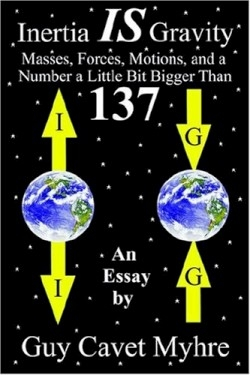Inertia IS Gravity
Masses, Forces, Motions, and a Number a Little Bit Bigger Than 137
“A pilot-training centrifuge gone wild can kill people while they are sitting down. From where does this killing force come?…inertial force is considered to be an artificial or pseudo force, which would shock many people who are dead because of the morbid reality of it.” Guy Cavet Myhre in Inertia Is Gravity comes to the conclusion that inertial force is “actually aggregated gravitational force on a grand, universal scale.”
Myhre, whose career has ranged from USAF pilot to French chef, computer science professor, and technical writer, has for many years pursued an interest in physical forces as a hobby. Now after his retirement shares with readers the fruit of many years of thought and research as an amateur physicist. Professionals should sit up and take notice.
After carefully defining relevant terms, Myhre takes readers on an imaginary voyage through the galaxy, experiencing and explaining the various forces at work. We experience falling and travel to the center of the earth: “Finally the elevator stops and we examine ourselves. We are weightless because the surrounding mass of Earth pulls us equally in every possible direction.” We also find out what it would be like to be alone in a massless universe, to be an electron-sized particle, and what it is like to fall to Earth (we feel weightless while falling).
Thought experiments are fun and interesting, but Myhre begins to shake our world when he talks about mathematical calculations related to these ideas. To simplify his exploration of forces, Myhre developed a system of measure based on quantum scale sizes. This simplification led to a series of discoveries about relationships between forces, masses, and universal constants.
Most of the universal constants are necessary only because the system of measurement used doesn’t line up with the quantum size whole units which cannot be divided. He also discovered that the beta ratio is not only “the ratio between the magnitude of the mass of the proton over that of the electron,” but also “the ratio between the magnitudes of all the other corresponding quantum attributes of the electron and proton.” He found that the probable definition of the fine structure constant is the ratio between the magnitudes of local inertia and the universal minimum, and that this reveals the meaning of the mystery number, 137. “Richard Feynman once stated that ‘Physicists put this number on the wall and worry about it.’” What does it mean? We seem to have the answer, but no one knows what the question is. Myhre suggests that 137 is the magnitude of local inertia in our part of the galaxy. He has also become convinced of the existence of gravitons and masstrons, and explains Heisenberg’s uncertainty principle. He talks about Bohr units of length and time, Plank’s cavity radiancy, Einstein’s quantum energies, and more.
This is a work of major insight, which strengthens the foundations of quantum physics by simplifying and clarifying our understanding of the proportionality between masses, forces, and motions. Anyone who seriously desires to study physics will want to be aware of these insights.
Disclosure: This article is not an endorsement, but a review. The publisher of this book provided free copies of the book and paid a small fee to have their book reviewed by a professional reviewer. Foreword Reviews and Clarion Reviews make no guarantee that the publisher will receive a positive review. Foreword Magazine, Inc. is disclosing this in accordance with the Federal Trade Commission’s 16 CFR, Part 255.

